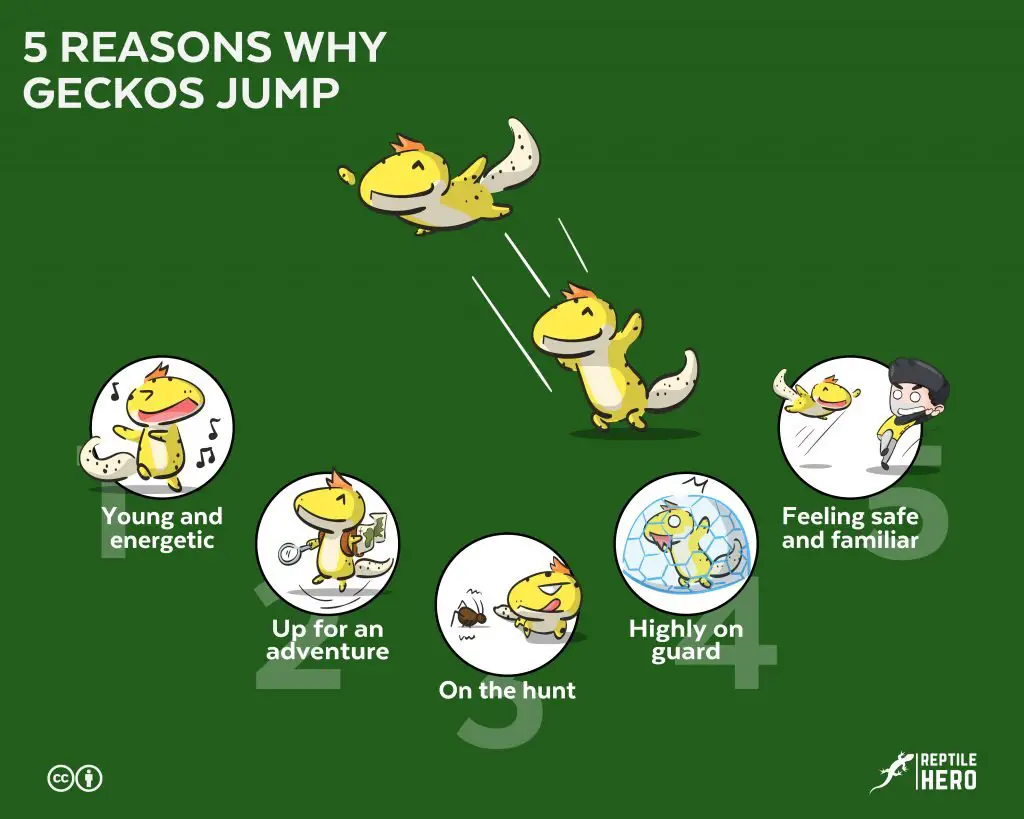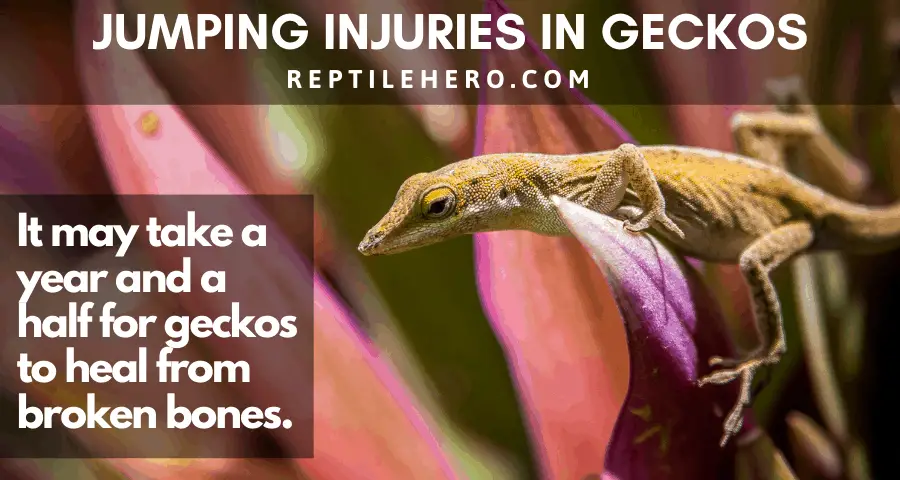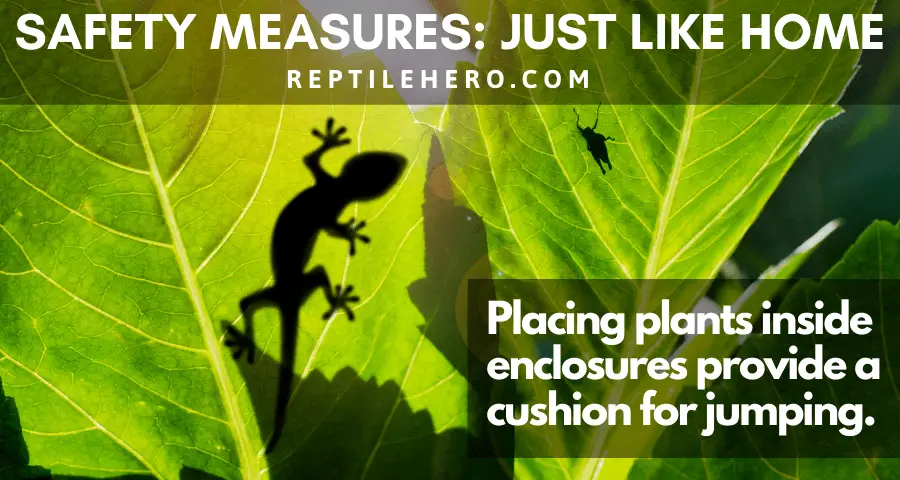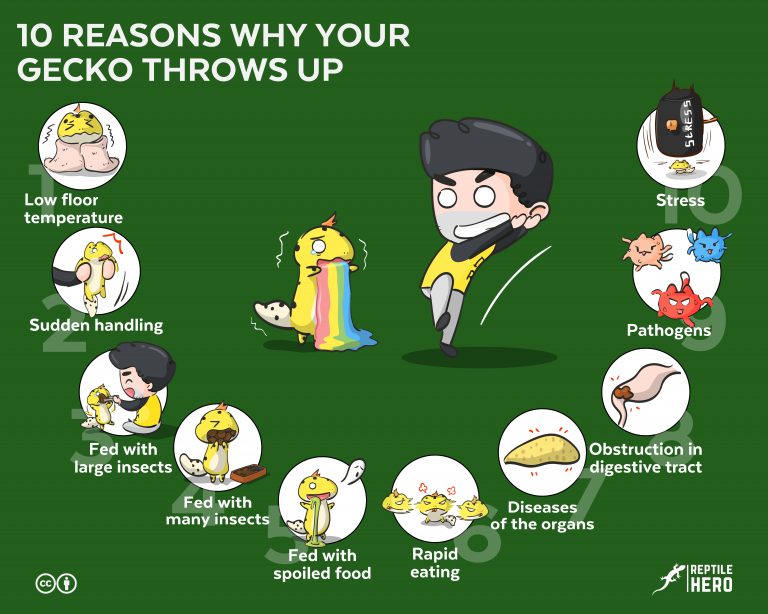The 5 Reasons Why Do Your Geckos Jump [and 5 Precautions]
If you’ve yet to witness your soft little baby jump off from his or her enclosure or your shoulder, I’d say prepare your heart for the inevitable. When my very first gecko did a nosedive out of nowhere, I almost had a heart attack! After that I started to mull over the incident – why do geckos jump?
Geckos tend to jump often when they are young, exploring their surroundings, hunting for food, sensing danger, or feeling familiar. Although such behavior is normal, geckos may still sustain injuries, especially when they have nutritional secondary hyperparathyroidism. Thus, it is important to mitigate risks.
Now before you go jumping to conclusions, read on as I further explain this phenomenon.
5 Reasons Why Geckos Jump
You’ve probably heard of leaping frogs before, but have you ever heard about leaping geckos? If not, you might not have one in your care just yet. Many new and experienced hobbyists have shared stories of their geckos jumping about, but why do they do that?

#1 – Young and Energetic
Like many other animals, geckos can be incredibly active during their younger years. Others would describe the hatchling to juvenile stages of geckos as their jumpiest. For the most part, this is apparent when trying to handle them.
Remember, babies eat a lot more than adults because they are still developing. More food, of course, means more energy to explore and play around with. Just let them jump about as much as they want to let them burn all the excess calories. By doing, they won’t run the risk of becoming overweight. An active baby gecko is a healthy baby gecko.
However, having them suddenly jump off from your hand or arm can understandably be quite stressful for both you and your gecko. After sticking the landing from a high place for the first time, they may either run off spooked or stay there dazed – similar to the act of stargazing displayed by geckos with enigma syndrome.
Your gecko’s tail may also start twitching, a sure sign of stress and an indication of possible dropping. If this happens, don’t abruptly try to handle them or the tail dropping possibility may turn into a certainty.
Hopefully, your little gecko will learn not to just jump from such high places in the future. In the event that he or she still tries to go skydiving, block his or her way with your palm.
#2 – Up For an Adventure
If you have a giant day gecko or a crested gecko (both of which are arboreal species) as members of your ever-growing family, you’re more likely to see them jump from vines, branches, and other greeneries within their enclosures.
This is because they are naturally going from one tree to the next in the wild, it’s simply one of their many means of traveling around the tropics.
So if you have plenty of big plants with sturdy stems and branches at home, place them close together to create your own little urban forest. Your gecko will for sure enjoy climbing and jumping around them, let him or her go and explore like this handsome little fellow.
#3 – On the Hunt
There are definitely some geckos that need a little help with foraging. However, these soft-bellied animals are actually superb hunters in their natural habitats.
If you’ve ever fed them live feeder insects, you’ve surely seen your baby pounce on their targets from different locations; from behind after stalking their unsuspecting prey, from below when locusts and crickets have gone for higher ground, or from above hidden among the lush foliage.
I imagine that geckos pouncing on live insects instead of simply walking or running towards them are since it gives their prey fewer chances of reacting fast enough to evade capture. The element of surprise greatly works to their advantage during ambush foraging, also known as the sit-and-wait mode of predation.
#4 – Highly on Guard
In the wild, geckos have numerous larger animals, such as snakes, that prey on them due to their small size. Seeing how that’s a cause for major concern in terms of survival, it makes sense how they’re easy to startle and stress.
They easily get keyed up at the slightest sudden sound – your voice, a door opening, a coin dropping, etc. So even if they have been in your care for years and have no issues at all with being handled, they’re still quick to alarm.
Geckos that are incredibly alarmed may go for what other keepers have termed as a “suicide dive.” However, this term doesn’t really sound right because I don’t think they actually intend to off themselves by doing so.
In fact, they most probably dive off for the exact opposite reason – for survival. When startled or threatened, geckos will do an escape jump. Tail dropping [1] may also happen along with the jump.
Cornering and getting in the way of an extremely wary gecko is not the right way to go about things. By doing so, you may just provoke them into going on the offense as they have no other means of escape. Tokay geckos are especially inclined to jump and bite when they feel unsafe.
#5 – Feeling Safe and Familiar
In complete contrast to the reason I’ve just previously mentioned, geckos may also jump towards you as a sign of familiarity. Other keepers even go so far as to say it’s proof that geckos can feel affection for them.
I’m not sure if I can wholeheartedly agree with the latter, but it’d be amazing if that was the case. The former, however, is most likely the actual explanation for such jumps. I mean, if your gecko viewed you as a threat he or she wouldn’t be willingly jumping into your embrace to put him or herself in danger.
Other keepers even share experiences of being treated as some kind of jungle gym or a friendly moving tree. Their geckos would happily jump from their head to their shoulder or back and forth their arms.
Just watch as this giant day gecko calmly jumps onto his keeper’s leg, then peacefully climb onto his palm:
Dangers Of Jumping For Geckos
Many hobbyists have brought up experiences of geckos jumping right out of their hands. And that loud “splat” sound they make upon coming into contact with the cold hard floor is more than enough to make any keeper’s hair stand on end. But is it actually as harmless as others claim it to be?
In Wilderness Vs. In Captivity
Others brush off high jumps as normal and nothing to worry about as they can do just fine in the wild even without any medical attention from exotic veterinarians. They assert that if lizards were so fragile, they would have long gone extinct.
This may be true for arboreal species, in particular, as they live high up in canopies and can easily jump from heights that are 9 times their snout-vent length – measured from the tip of their snouts to the base of their tails.
But jumping from towering heights with large leaves to cushion their fall before landing on a relatively soft mossy ground is completely different from falling smack-dab onto firm cement. If a tree-dwelling gecko can get injured from that, then I could only begin to imagine what could possibly become of a terrestrial gecko.
Hidden Injuries
While it’s true that reptiles are tough creatures capable of surviving a fall from heights that could prove fatal for humans, I would still advise against letting your geckos repeatedly dive straight for the ground.
A fall that barely leaves a scratch on some geckos could be deadly to another. Not to mention, it can be trickier to tell when reptiles are sick or injured. One expert even shares her amazement with badly hurt reptiles acting normally as though things are all sunshine and rainbows.
So although your charming gecko may seem unscathed, it’ll be better to pay the local vet a visit to check for internal injuries:
- internal bleeding
- visceral rupture
- broken bones
It’s always better safe than sorry, right?
Weak Bones And High Jumps

As with any other living creature on earth, a healthy and balanced diet is essential for overall well-being. In line with this, geckos need calcium and vitamin D3 for strong bones that could withstand falls that are several feet high.
Consistent deficiency of the aforementioned dietary needs could result in the development of nutritional secondary hyperparathyroidism, most commonly referred to as metabolic bone disorder (MBD). And the truth or the matter is: reptiles kept as pets are prone to suffering from fractures due to weakened bones caused by MBD.
Bone fractures rarely ever become a life-and-death situation for geckos and other reptiles, nevertheless, it could come with a handful of serious complications such as infections. So it’s in your best interest to look out for the following symptoms if your gecko skydives out of the blue:
- Limping or dragging of legs
- Bruising or discoloration
- Bones protruding abnormally
- Swelling in the limbs or jaw
- Twitching in any part of the body
- Difficulty in eating, or not eating at all
- Issues with waste excretion
- Total or partial paralysis
- Tail damage or rot
- Abnormal gait
If you notice any of these in your gecko, restrict their movement to avoid further exacerbating their injuries and take them to the vet for proper diagnosis and treatment.
Keep in mind that compared to mammals that grow up drinking their mother’s milk, reptiles have bones that heal much slower. It may take a minimum of 2 months and a maximum of 1 1/2 years for reptile bones to fully heal.
5 Safety Measures For Jumpy Geckos
While it’s perfectly normal for geckos to jump about, it’s not necessarily safe – especially for non-arboreal species. Make sure to keep the following in mind to minimize the risks that come with your gecko’s jumping.
#1 – Give Them Time And Space
If you’ve only recently gotten yourself a gecko, expect them to be considerably easy to stress out during their first two weeks in your home. This is nothing to be especially worried about, they just need some time to get themselves more familiar with you and your place.
Don’t rush things, especially touching and carrying your gecko. That would just be counterproductive. Actually, they might even take longer to get friendly with you – or at least accepting of your presence – if you try to force it.
#2 – Stay Hush-Hush
Have you ever noticed how the sound of our voices changes when talking to babies? How we soften up and slow down? Or use a sing-song voice? Well, doing the same with your reptile babies could actually do wonders for your relationship as well.
Since it’s quite easy to scare them off, talking to them in a soothing voice can help bring their guards down a bit around you. It would be even better if you start doing this while they’re still young so that they do not see you as a threatening presence.
#3 – Keep Your Feet On The Ground
Some geckos just seem to be complete thrill-seekers, jumping off with reckless abandon. Not learning from past falls, they seem to enjoy skydiving – well at least that’s what other gecko hobbyists say.
If this sounds familiar to you, you might want to start being as close to the ground as possible when handling your precious gecko out of his or her vivarium. Just sit down on the floor or sofa. At the very least, the chance of him or her getting injured after diving into thin air is less likely. Other keepers with children at home also go by the “sit down” rule.
Setting up a playpen for your geckos could also be great, given that you pay close attention to them whilst they’re jumping around the place.
I’ve heard from other keepers that using a clean plastic box or basin as a makeshift safety net is also effective when handling jumpy terrestrial species like leopard geckos. Having a carpet laid out on the floor could also work great as a shock absorber.
#4 – Make Them Feel At Home

Like I’ve already mentioned before, the natural habitats of geckos make their jumps much safer. So, mimic their habitat as much as you can. Add things that are not only decorative but also have a practical use.
To achieve a homey feel, fellow reptile hobbyists also swear by realistic wallpapers and backgrounds simulating natural gecko environments. Of course, plants, vines, and branches – fake or not – are really great additions as well. They are cool to the eyes and make jumping safe.
Great options for a more natural substrate would be a 7:3 mix of topsoil and play sand or commercially available bedding mixes (here on Amazon) for safer landings in the tank.
Keepers have also suggested using a reptile carpet (here on Amazon) for substrate instead as it comes with tons of pros: it’s eco-friendly, soft, non-abrasive, adjustable, washable, and poses no risk of impaction due. Not everyone’s a fan of the carpet though. Then again all substrate choices have their own set of advantages, disadvantages, and risks.
Another pro tip: if your gecko keeps jumping into the sides of its enclosure, it’s too small. Taller tanks are great for arboreal species while wider tanks are great for terrestrial species. You could go for glass terrariums that are 18 x 18 x 24 inches (here on Amazon) or 36 x 18 x 36 inches (here on Amazon).
#5 – Put A Lid On It
Numerous other keepers have had to deal with geckos escaping during cleaning or after inadvertently – at times, intentionally – leaving the top of their tanks opens.
Pet parents of terrestrial species, like leopard geckos, are especially likely to underestimate the jumping reach of the lizards in their care. Unsurprisingly, their agile and energetic babies dart out of their enclosures upon seeing an opening. Some leos are even capable of escaping tanks that are a whole foot tall.
So, it’s important to have a secure temporary shelter on hand for your geckos when you need to travel with them or clean out their vivarium.
If you’ve seen geckos in hamster balls before, I can almost see a light bulb go on in your head. But before you even ask, I’ll give you the straight answer; no, hamster balls are not good for geckos even for temporary housing.
Instead, I’d advise that you find a sturdy plastic critter container (here on Amazon) that’s big enough to comfortably house your gecko. Or if you have an old plastic storage bin with a lid, just clean, disinfect, and solder ventilation holes on it. Voila! You’ve got yourself a cheap temporary gecko shelter!
How Do Geckos Stick The Landing?
As you may have already observed, geckos usually land feet-first after falling or jumping, much like cats. But given the difference in their size and body structure, how are they both capable of doing it?
Unlike cats who use their whole body to twist mid-air for them to land with all four paws meeting the ground, geckos whirl their tails around and use the gathered momentum from that movement to rotate their bodies until they’re finally right-side up [2]. This ability is called the air-righting reflex.
The average gecko can right itself to land with its belly facing the floor during a fall within just 100 milliseconds. This record beats that of cats and any other wingless animal. Regardless of where they jumped from or what position they were in before that, they will always land stomach-side down with the use of their long and/or bulky tails.
Effect Of Tail Loss On Jumping
In an earlier article, we briefly mentioned the fact that geckos store fat in their tails. But that’s not all there is to their tails. Aside from that, tails are crucial for:
- Distracting and escaping predators
- Climbing up shrubs and trees
- Landing safely on the ground after jumps and falls
- Moving quickly in big strides
- Maintaining balance
One study even clearly demonstrates how geckos are able to safely orient themselves mid-air and effortlessly glide over to a solid landing platform when placed over a vertical wind tunnel.
From all that, we can say for sure that tails are important for normal gecko locomotion. So what happens when they voluntarily amputate their tails? Well, take a look at this video to see how not having a tail can affect jumping in lizards in general.
To elaborate, geckos that are heavily reliant on their tails for balance, propulsion, and safe landing are likely to experience bad falls after caudal autotomy, otherwise known as tail dropping. Without their tails, they could continue to spin uncontrollably before hitting the ground. This is in spite of the fact that they also use their hind legs to catapult themselves off the ground or down from the canopies.
Takeaways
- Geckos naturally jump when they are young, exploring their surroundings, hunting for food, sensing danger, or feeling familiar.
- Insufficient dietary calcium and vitamin D3 put geckos at greater risk of sustaining injuries, such as fractures, from jumping.
- Lizards, including geckos, are capable of landing stomach-side down whenever they jump by twisting their tail to stabilize themselves.
- Tail loss equates to the loss of air-righting abilities in jumping geckos that could result in bad falls.
Sources
[1] https://www.sciencedirect.com/topics/veterinary-science-and-veterinary-medicine/autotomy



![Why Do Leopard Geckos Poop in the Same Spot? [Wild Nature]](https://www.reptilehero.com/wp-content/uploads/2022/03/why-geckos-poop-in-one-spot-cc-1-768x614.jpg)
![10 Reasons Why Your Gecko Is Sneezing [With Solutions]](https://www.reptilehero.com/wp-content/uploads/2021/03/Why-gecko-sneeze-cc-768x614.jpg)

![8 Reasons Why Your Gecko Bury Itself? [Crested and Leopard]](https://www.reptilehero.com/wp-content/uploads/2021/02/Gecko-Bury-cc-768x614.jpg)
